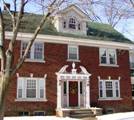
Colonial Revival (1876s – 1955s)
Expressing American patriotism and a return to classical architectural styles, Colonial Revival became a standard style in the 20th century.
History:
Colonial Revival became a popular American house style after it appeared at the 1876 the US Centennial Exposition. Reflecting American patriotism and a desire for simplicity, the Colonial Revival house style remained popular until the mid-1950’s. Between World War I and II, Colonial Revival was the most popular historic revival house style in the United States.
Some architectural historians say that Colonial Revival is a Victorian style; others believe that the Colonial Revival style marked the end of the Victorian period in architecture. The Colonial Revival style is based loosely on Federal and Georgian house styles, and a clear reaction against excessively elaborate Victorian Queen Anne architecture. Eventually, the simple, symmetrical Colonial Revival style became incorporated into the Foursquare and Bungalow house styles of the early 20th century.
Subtypes of the Colonial Revival House Style are:
Dutch Colonial: Two-story house made of clapboard or shingles with a gambrel roof, flared eaves, and a side-entry floor plan.
Garrison Colonial: The second story protrudes; the first story is slightly recessed.
Saltbox Colonial: Like the original saltbox homes from colonial times, a Saltbox Style Colonial Revival has two stories at the front and one story at the rear. The gable roof covers both levels, sloping sharply down in the rear.
Spanish Colonial Revival: Low-pitched ceramic tile roof, stucco walls, eaves with little or no overhang, wrought iron, and windows and doorways with round arches.
Features:
Symmetrical façade
Rectangular
2 to 3 stories
Brick or wood siding
Simple, classical detailing
Gable roof
Pillars and columns
Multi-pane, double-hung windows with shutters
Dormers
Temple-like entrance: porticos topped by pediment
Paneled doors with sidelights and topped with rectangular transoms or fanlights
Center entry-hall floor plan
Living areas on the first floor and bedrooms on the upper floors
Fireplaces
Next: Neoclassical